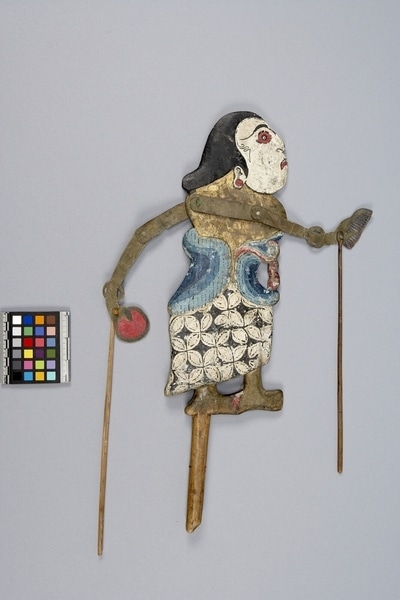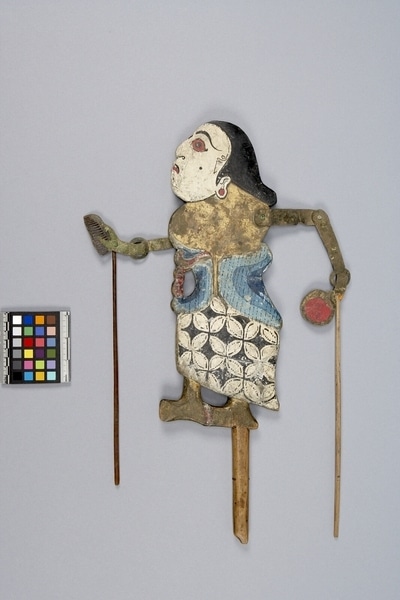Shadow Puppet Item Number: Ib363 from the MOA: University of British Columbia


Description
Partially two-dimensional, but fairly flat, human figure. Jointed arms tied to shoulders, without recognizable hands, and tied to controlling rods. Black hair swept back without headdress. Wide white face with red eyes and lips and ear ornaments. Facial details in black. Gold upper torso and arms. Garment covering lower torso in various shades of blue. Red hanging. Black and white floral design on skirt. Arm to left with grate-like member. Arm to right with circular member with red centre.
History Of Use
Javanese puppetry as an art form probably developed by the 11th century. Wayang klikit puppetry is a minor form of shadow theatre. Originally the plays depicted Javanese mythology, but after contact with India the Hindu epics, Ramayana and Mahabharata, became predominant in the cycles, which comprise about 200 plays. A dalang (puppet master) performs the plays to celebrate important occasions, usually in three acts, with vocal and instrumental accompaniment. Typically they serve a moral and religious purpose. Although the custom varies, men typically observe the plays on the dalang's side of the screen, thus directly partaking of the spiritual elements of the drama. Women and children are excluded, watching only the shadows from the opposite side of the screen. Each puppet's character is represented by its appearance and placement onstage; good characters are placed to the right, evil to the left. A role, or traditional appearance of this puppet has not been determined.
Iconographic Meaning
Each puppet is characterized by it's wanda, a Javanese word which describes the specific mixture of elements of size, form, colour, ornamentation and carving. Very unusual puppet; many traits are contradictory. Significance of strange arms not determined. White face usually suggests innocence or goodness. Gold skin depicts youth or calm disposition. Red eyes found on evil characters. Bare chest suggests that character is not of human ancestry. Role or identity of character is not known; extremely non-traditional.
Cultural Context
Theatrical performance.
Item History
- Made in Java, Indonesia
- Owned by Tradewind Antiques before March 15, 1983
- Received from Museum of Anthropology Shop Volunteers (Funding source) and Tradewind Antiques (Seller) on March 15, 1983
What
Who
- Culture
- Javanese
- Previous Owner
- Tradewind Antiques
- Received from
- Museum of Anthropology Shop Volunteers (Funding source) and Tradewind Antiques (Seller)
Where
- Holding Institution
- MOA: University of British Columbia
- Made in
- Java, Indonesia
When
- Ownership Date
- before March 15, 1983
- Acquisition Date
- on March 15, 1983
Other
- Condition
- fair
- Accession Number
- 0886/0097